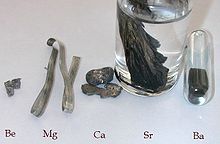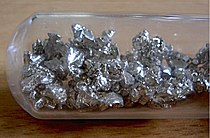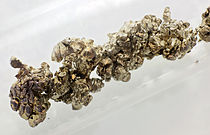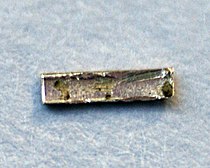క్షారమృత్తిక లోహము
|
క్షార లోహాలు ← → గ్రూపు 3 మూలకాలు
| |||||||||||||||||||||||||||||||||||||||||||||||||||||||||||||||||||||||||||||||||||||||||||||||||||||||||||||||||||||||||||||||||||||||||||||||||||||||||||||||||||||||||||||||||||||||||||||||||||||||||||||||||||||||||||||||||
| |||||||||||||||||||||||||||||||||||||||||||||||||||||||||||||||||||||||||||||||||||||||||||||||||||||||||||||||||||||||||||||||||||||||||||||||||||||||||||||||||||||||||||||||||||||||||||||||||||||||||||||||||||||||||||||||||
| ↓ Period | |||||||||||||||||||||||||||||||||||||||||||||||||||||||||||||||||||||||||||||||||||||||||||||||||||||||||||||||||||||||||||||||||||||||||||||||||||||||||||||||||||||||||||||||||||||||||||||||||||||||||||||||||||||||||||||||||
| 2 | బెరీలియం (Be) 4 | ||||||||||||||||||||||||||||||||||||||||||||||||||||||||||||||||||||||||||||||||||||||||||||||||||||||||||||||||||||||||||||||||||||||||||||||||||||||||||||||||||||||||||||||||||||||||||||||||||||||||||||||||||||||||||||||||
| 3 | మెగ్నీషియం (Mg) 12 | ||||||||||||||||||||||||||||||||||||||||||||||||||||||||||||||||||||||||||||||||||||||||||||||||||||||||||||||||||||||||||||||||||||||||||||||||||||||||||||||||||||||||||||||||||||||||||||||||||||||||||||||||||||||||||||||||
| 4 | కాల్షియం (Ca) 20 | ||||||||||||||||||||||||||||||||||||||||||||||||||||||||||||||||||||||||||||||||||||||||||||||||||||||||||||||||||||||||||||||||||||||||||||||||||||||||||||||||||||||||||||||||||||||||||||||||||||||||||||||||||||||||||||||||
| 5 | స్ట్రాన్షియం (Sr) 38 | ||||||||||||||||||||||||||||||||||||||||||||||||||||||||||||||||||||||||||||||||||||||||||||||||||||||||||||||||||||||||||||||||||||||||||||||||||||||||||||||||||||||||||||||||||||||||||||||||||||||||||||||||||||||||||||||||
| 6 | బేరియం (Ba) 56 | ||||||||||||||||||||||||||||||||||||||||||||||||||||||||||||||||||||||||||||||||||||||||||||||||||||||||||||||||||||||||||||||||||||||||||||||||||||||||||||||||||||||||||||||||||||||||||||||||||||||||||||||||||||||||||||||||
| 7 | రేడియం (Ra) 88 | ||||||||||||||||||||||||||||||||||||||||||||||||||||||||||||||||||||||||||||||||||||||||||||||||||||||||||||||||||||||||||||||||||||||||||||||||||||||||||||||||||||||||||||||||||||||||||||||||||||||||||||||||||||||||||||||||
|
Legend
| |||||||||||||||||||||||||||||||||||||||||||||||||||||||||||||||||||||||||||||||||||||||||||||||||||||||||||||||||||||||||||||||||||||||||||||||||||||||||||||||||||||||||||||||||||||||||||||||||||||||||||||||||||||||||||||||||

విస్తృత ఆవర్తన పట్టికలో రెండవ గ్రూపులో అమర్చిన బెరీలియం (Be), మెగ్నీషియం (Mg), కాల్షియం (Ca), స్ట్రాన్షియం (Sr), బేరియం (Ba), రేడియం (Ra) మూలకాలను 'క్షార మృత్తిక లోహాలు' అంటారు.[1] ఈ మూలకాలన్నీ మెరుపు గుణం కలిగి, సిల్వర్ రంగు గల తెలుపుతో ఒకే రకమైన ధర్మాలను ప్రదర్శిస్తాయి. ఇవి సాధారణ ఉష్ణోగ్రతా పీడనాల వద్ద ఎక్కువ చర్యాశీలత గల లోహాలు.[2]
నిర్మాణత్మకంగా ఈ మూలకాల పరమాణువులోని బాహ్య కక్ష్యలో s-ఆర్బిటాల్ పూర్తిగా రెండు ఎలక్ట్రాన్లతో నిండి ఉంటుంది.[2][3][4] అందువలన క్షారమృత్తికా లోహాలు సులువుగా రెండు ఎలక్ట్రాన్లను కోల్పోయి కాటయాన్లను ఏర్పరుస్తాయి. వీటి ఆవేశం +2, ఆక్సీకరణ స్థితి +2, ఉంటుంది.[5]
అన్ని క్షారమృత్తికా లోహాలు ప్రకృతిలో లభ్యమవుతాయి. రేడియం మాత్రం యురేనియం, ధోరియం వంటి భార లోహాల రేడియోధార్మిక విఘటనం చెందినపుడు ఆ విఘటన గొలుసులో లభ్యమవుతుంది.[6] ఈ మూలకాల గ్రూపులో స్ట్రాన్షియం తరువాత రావలసిన 120 పరమాణు సంఖ్య గల మూలకాన్ని ప్రయోగం ద్వారా తయారుచేయుటకు చేసిన ప్రయోగాలు సఫలం కాలేదు.
ధర్మాలు
[మార్చు]రసాయన
[మార్చు]ఈ మూలకాలు ఆవర్తన పట్టికలో రెండవ గ్రూపుకు చెందుతాయి. ఈ మూలకాల బాహ్య కక్ష్యలో ఎలక్ట్రాన్ విన్యాసం ఒకేలా ఉంటుంది. అందువలన ఇవి ఒకే విధమైన రసాయన ధర్మాలను కలిగి ఉంటాయి.
| Z | మూలకం | ఎలక్ట్రాన్ల సంఖ్య/కర్పరం | ఎలక్ట్రాన్ విన్యాసం[n 1] |
|---|---|---|---|
| 4 | బెరెలియం | 2, 2 | [He] 2s2 |
| 12 | మెగ్నీషియం | 2, 8, 2 | [Ne] 3s2 |
| 20 | కాల్షియం | 2, 8, 8, 2 | [Ar] 4s2 |
| 38 | స్ట్రాన్షియం | 2, 8, 18, 8, 2 | [Kr] 5s2 |
| 56 | బేరియం | 2, 8, 18, 18, 8, 2 | [Xe] 6s2 |
| 88 | రేడియం | 2, 8, 18, 32, 18, 8, 2 | [Rn] 7s2 |
రసాయన శాస్త్రంలో పై మూలకాలలో పై ఐదింటి ధర్మాలను పరిశీలించడం జరిగింది. కానీ రేడియం మూలకానికి ఉన్న రేడియోధార్మిక ధర్మం మూలంగా పూర్తిగా దాని రసాయన ధర్మాలను పరిశీలించలేదు.[2]
క్షార మృత్తికలోహాలు సిల్వర్ రంగులో మెత్తగా ఉంటాయి. అవి సాపేక్షంగా తక్కువ సాంద్రతను, ద్రవీభవన స్థానాన్ని, బాష్పీభవన స్థానాన్ని కలిగి ఉంటాయి. ఈ మూలకాలు హేజోజన్లతో రసాయన చర్య జరిపి వాటి లోహ హాలైడ్లను ఏర్పరుస్తాయి. అవి అయానిక స్పటిక సమ్మేళనాలు. బెరెలియం తప్ప అన్ని క్షార మృత్తిక లోహాలు నీటితో చర్య జరిపి క్షార హైడ్రాక్సైడ్లను ఏర్పరుస్తాయి. భారయుత క్షార మృత్తికలోహము తేలికపాటి లోహం కన్నా ఎక్కువ చర్యాశీలత కల్గి ఉంటాయి.[2] క్షార మృత్తిక లోహాలు ఆవర్తన పట్టిలలో వాటి పీరియడ్లలో రెండవ అతి తక్కువ మొదటి అయనీకరణ శక్తిని కలిగి ఉంటాయి[4]. క్షారమృత్తిక లోహాల రెండవ అయనీకరణ శక్తి కూడా తక్కువగా ఉంటుంది.[2][4]
బెరిలియం ఒక మినహాయింపు: ఇది నీరు లేదా ఆవిరితో చర్య జరపదు. దాని హాలైడ్లు సమయోజనీయమైనవి. బెరీలియం కలిగి ఉన్న అన్ని సమ్మేళనాలు సమయోజనీయ బంధాన్ని కలిగి ఉంటాయి.[7] బెరెలియం సమ్మేళనాలలో బెరెలియం ఫ్లోరైడ్ ఎక్కువ అయానిక సమ్మేళనము. ఇది తక్కువ ద్రవీభవన స్థానం, గలన స్థితిలో తక్కువ విద్యుద్వాహకత కలిగి ఉంటుంది.[8][9][10]
అన్ని క్షార మృత్తిక లోహాల భాహ్య కర్పరంలో రెండు ఎలక్త్రాన్లు ఉన్నాయి. సంయోజకత 2 ఉన్నందున అష్టకం పొందడానికి రెండు ఎలక్ట్రాన్లను కోల్పోయి ధనాత్మక అయాన్లను ఏర్పరుస్తాయి. అన్నీ ద్వసంయోజక అయాన్లనిస్తాయి.
భౌతిక ధర్మాలు
[మార్చు]ఈ క్రింది పట్టికలో క్షారమృత్తిక లోహాల భౌతిక ధర్మాలను సుచించడం జరిగింది.
| క్షార
మృత్తిక లోహం |
ప్రామాణిక
పరమాణు భారం |
ద్రవీభవన
స్థానం (K) |
ద్రవీభవన
స్థానం (°C) |
బాష్పీభవన | సాంద్రత
(g/cm3) |
ఋణ
విద్యు దాత్మకత పాలింగ్ |
ప్రథమ
అయనీకరణ శక్మం |
సంయోజనీయ
వ్యాసార్థం |
జ్వాల
పరీక్ష రంగు | ||
|---|---|---|---|---|---|---|---|---|---|---|---|
| బెరెలియం | 9.012182 (3) | 1560 | 1287 | 2742 | 2469 | 1.85 | 1.57 | 899.5 | 105 | తెలుపు[15] | |
| మెగ్నీషియం | 24.3050 (6) | 923 | 650 | 1363 | 1090 | 1.738 | 1.31 | 737.7 | 150 | బ్రిలియంట్
తెలుపు[2] |
|
| కాల్షియం | 40.078 (4) | 1115 | 842 | 1757 | 1484 | 1.54 | 1.00 | 589.8 | 180 | ఇటుక
ఎరుపు[2] |
|
| స్ట్రాన్షియం | 87.62 (1) | 1050 | 777 | 1655 | 1382 | 2.64 | 0.95 | 549.5 | 200 | క్రిమ్సన్[2] | |
| బేరియం | 137.327 (7) | 1000 | 727 | 2170 | 1897 | 3.594 | 0.89 | 502.9 | 215 | ఆపిల్
గ్రీన్[2] |
|
| రేడియం | [226][n 3] | 973 | 700 | 2010 | 1737 | 5.5 | 0.9 | 509.3 | 221 | క్రిమ్సన్
రెడ్[n 4] |
|
గ్రంథావళి
[మార్చు]- Weeks, Mary Elvira; Leichester, Henry M. (1968). Discovery of the Elements. Easton, PA: Journal of Chemical Education. LCCCN 68-15217.
ఇతర పఠనాలు
[మార్చు]- Group 2 – Alkaline Earth Metals, Royal Chemistry Society.
- Hogan, C.Michael. 2010. Calcium. eds. A.Jorgensen, C. Cleveland. Encyclopedia of Earth. National Council for Science and the Environment.
- Maguire, Michael E. "Alkaline Earth Metals." Chemistry: Foundations and Applications. Ed. J. J. Lagowski. Vol. 1. New York: Macmillan Reference USA, 2004. 33–34. 4 vols. Gale Virtual Reference Library. Thomson Gale.
- Silberberg, M.S., Chemistry: The molecular nature of Matter and Change (3e édition, McGraw-Hill 2009)
- Petrucci R.H., Harwood W.S. et Herring F.G., General Chemistry (8e édition, Prentice-Hall 2002)
నోట్సు
[మార్చు]- ↑ Noble gas notation is used for conciseness; the nearest noble gas that precedes the element in question is written first, and then the electron configuration is continued from that point forward.
- ↑ The number given in parentheses refers to the measurement uncertainty. This uncertainty applies to the least significant figure(s) of the number prior to the parenthesized value (i.e., counting from rightmost digit to left). For instance, 1.00794(7) stands for 1.00794±0.00007, whereas 1.00794(72) stands for 1.00794±0.00072.[11]
- ↑ The element does not have any stable nuclides, and a value in brackets indicates the mass number of the longest-lived isotope of the element.[12][13]
- ↑ The color of the flame test of pure radium has never been observed; the crimson-red color is an extrapolation from the flame test color of its compounds.[16]
మూలాలు
[మార్చు]- ↑ మూస:RedBook2005.
- ↑ 2.0 2.1 2.2 2.3 2.4 2.5 2.6 2.7 2.8 Royal Society of Chemistry. "Visual Elements: Group 2–The Alkaline Earth Metals". Visual Elements. Royal Society of Chemistry. Archived from the original on 5 October 2011. Retrieved 13 January 2012.
- ↑ "Periodic Table: Atomic Properties of the Elements" (PDF). nist.gov. National Institute of Standards and Technology. September 2010. Archived (PDF) from the original on 2012-08-09. Retrieved 17 February 2012.
- ↑ 4.0 4.1 4.2 4.3 4.4 Lide, D. R., ed. (2003). CRC Handbook of Chemistry and Physics (84th ed.). Boca Raton, FL: CRC Press.
- ↑ Greenwood, Norman N.; Earnshaw, Alan (1997). Chemistry of the Elements (2nd ed.). Butterworth-Heinemann. ISBN 0080379419.
- ↑ "Abundance in Earth's Crust". WebElements.com. Archived from the original on 9 March 2007. Retrieved 14 April 2007.
- ↑ Jakubke, Hans-Dieter; Jeschkeit, Hans, eds. (1994). Concise Encyclopedia Chemistry. trans. rev. Eagleson, Mary. Berlin: Walter de Gruyter.
- ↑ Bell, N. A. (1972). "Beryllium halide and pseudohalides". In Emeléus, Harry Julius; Sharpe, A. G. (eds.). Advances in inorganic chemistry and radiochemistry, Volume 14. New York: Academic Press. pp. 256–277. ISBN 978-0-12-023614-5.
- ↑ Walsh, Kenneth A. (2009-08-01). Beryllium chemistry and processing. ASM International. pp. 99–102, 118–119. ISBN 978-0-87170-721-5.
- ↑ Hertz, Raymond K. (1987). "General analytical chemistry of beryllium". In Coyle, Francis T. (ed.). Chemical analysis of metals: a symposium. ASTM. pp. 74–75. ISBN 978-0-8031-0942-1.
- ↑ "Standard Uncertainty and Relative Standard Uncertainty". CODATA reference. National Institute of Standards and Technology. Archived from the original on 16 October 2011. Retrieved 26 September 2011.
- ↑ 12.0 12.1 Wieser, Michael E.; Berglund, Michael (2009). "Atomic weights of the elements 2007 (IUPAC Technical Report)" (PDF). Pure Appl. Chem. 81 (11). IUPAC: 2131–2156. doi:10.1351/PAC-REP-09-08-03. S2CID 98084907. Archived (PDF) from the original on 2 November 2012. Retrieved 7 February 2012.
- ↑ 13.0 13.1 Wieser, Michael E.; Coplen, Tyler B. (2011). "Atomic weights of the elements 2009 (IUPAC Technical Report)" (PDF). Pure Appl. Chem. 83 (2). IUPAC: 359–396. doi:10.1351/PAC-REP-10-09-14. S2CID 95898322. Archived (PDF) from the original on 11 February 2012. Retrieved 11 February 2012.
- ↑ Slater, J. C. (1964). "Atomic Radii in Crystals". Journal of Chemical Physics. 41 (10): 3199–3205. Bibcode:1964JChPh..41.3199S. doi:10.1063/1.1725697.
- ↑ Jensen, William B. (2003). "The Place of Zinc, Cadmium, and Mercury in the Periodic Table" (PDF). Journal of Chemical Education. 80 (8). American Chemical Society: 952–961. Bibcode:2003JChEd..80..952J. doi:10.1021/ed080p952. Archived from the original (PDF) on 2010-06-11. Retrieved 2012-05-06.
- ↑ Kirby, H. W; Salutsky, Murrell L (1964). The Radiochemistry of Radium. National Academies Press.[permanent dead link]





